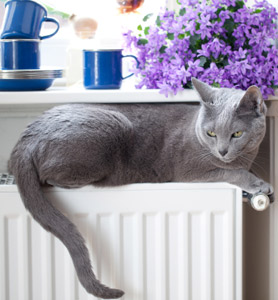A Safe Environment for Cats

Having a cat around the house is sort of like having a toddler. Both are very curious and like to explore their surroundings. As with a toddler, you’ll need to protect your cat from things that could potentially be dangerous to him. Start by taking a walk around your home and looking for things that could be harmful to your cat. Even everyday items can dangerous. Put away sharp objects, cleaning supplies, and anything that he/she could choke on (buttons, coins, jewelry, paper clips, etc.) Check under the couch for small things that may have fallen under there that he could easily get a hold of.
Plants
Certain kinds of plants can be toxic to cats. Chewing on certain plants can lead to severe mouth, throat, or stomach irritation, or even death. The following are some plants that, if ingested, can kill your cat: azalea, oleander, castor bean, sago palm, Easter Lily, and yew plant. If your cat ingests a poisonous plant, call your veterinarian immediately.
Of course, there are many plants that are safe for cats to be around and even to eat. You need to make it clear to your cat from the start which plants are acceptable for him to chew on. Keeping certain plants out of his reach is the best deterrent, but you can also try giving him a quick squirt from a spray bottle if he’s nibbling on a plant that you’ve deemed off-limits.
Fire
Curling up in front of the fireplace with your cat and a good book probably sounds like great idea for a cat lover. This can be quite enjoyable if the right precautions are taken, it provides an easy opportunity for your cat to be burned. Just like humans, cats can get burned by the actual fire or by a flying spark. To keep your cat safe, never leave him/her unattended near a burning or smoldering fire. This also applies to lit candles, the stove, an iron, or a grill.
Keep in mind that cats are excellent jumpers. With a good leap, a cat may be able to access places that you would have assumed unreachable for him/her. Cats are also intelligent creatures and often good problem solvers, so don’t put it past your cat to teach him/herself something like how to open a cabinet. Keeping these things in mind, take certain precautions that will keep you from spending so much time worrying about the safety of your cat, and give you more time to relax and enjoy time with your pet.
Plastic Bags
If you keep your cat indoors at all times, you will have less imminent threats to worry about, but there are still some dangerous things lurking inside every house. Plastic bags are one item that can be very harmful to your cat. Cats love to play, so a plastic bag looks a toy to them. While that grocery bag could certainly provide hours of amusement, it also has the potential to kill your cat. If the handle of a bag gets wrapped around his/her neck, he/she could easily choke. To avoid a terrible situation, keep all plastic bags away from your cat.
Outdoor Dangers
Some outdoor cats live long lives, but more often, the lives of outdoor cats are cut short by a variety of dangerous situations. The most common cause of death for a cat living outdoors is being hit by a car. Outdoors cats have no limits on where they can and can’t go. It’s extremely easy for them to wander into the road and meet with a terrible accident. Outdoor cats also risk getting caught up in a fight with another animal, which can lead to serious wounds or even death. They can also get trapped in bad weather, such as a thunderstorm or snowstorm, where they risk getting frostbite or hypothermia. There are also some people who find it amusing to tease or hurt animals, and your cat could be seriously harmed if he meets up with one of them. No matter how careful you are, there will always be some dangers for your cat, indoors or outdoors. Do the best you can to remove potentially harmful things from your cat’s path, but also be prepared in case a medical need arises.